With the state planning to develop new rail links and upgrade its roads, seaports and airports, construction is set to surge in Kuwait over the coming years. Plans to deliver hundreds of thousands of government-funded residential units by 2020 will also keep the sector on a growth path, despite challenges presented by reduced oil revenues and the rising cost of raw materials.
The country’s infrastructure sector is forecast to grow by 15-20% this year, according to investment bank Alpen Capital, with projects aimed at greater GCC integration and economic diversification also serving as key growth drivers.
The region’s broader economic strategy is expected to bolster this trend. The GCC plans to boost investment in the construction sector by showcasing the region as a tourist and investment destination, helping to increase the industry’s value from $91.5bn to $126.2bn in the three years to 2016, according to Alpen Capital’s June “GCC Construction Industry” report.
Infrastructure and housing in the driver’s seat
Kuwait’s construction industry is forging ahead with several large infrastructure projects, with planned developments worth an estimated $123.6bn, according to MEED, outpacing Qatar ($113.8bn), Oman ($29.6bn) and Bahrain ($25bn). In an analysis of the 100 largest construction contracts in the GCC in 2014, Kuwait came in third after the UAE and Saudi Arabia, based on the combined value of projects in the pipeline.
Progress has been promising to date. In June, Cairo-based Arab Contractors said the $855.7m Al Jahra road project – a 142-km highway connecting the industrial area of Shuwaikh to Kuwait City – was on track to be completed in 2016. The project is one of a number of planned infrastructure upgrades, along with the $2.6bn Sheikh Jaber Causeway, which will link Kuwait to Silk City, and the $7bn Kuwait City Metro, scheduled for completion in 2018 and 2019, respectively.
At the same time, rising demand for public housing is expected to drive long-term residential construction growth, with the Public Authority for Housing and Welfare announcing plans to build 174,000 housing units by 2020. Private contractors will be able to bid on a raft of developments, including the Mutlah Residential Project, Al Subiyah Residential City and Sabah Al Ahmad township, that together should help to reduce the waiting list for public housing, which currently ranges from 15 to 20 years.
The Kuwaiti government also plans to employ a public-private partnership model to deliver public housing, including 11,000 units under the Sabah Al Ahmad project, which will house up to 100,000 people upon completion.
Building blocks
Although the industry is poised for significant growth in the long run, contractors will nonetheless be faced with the rising cost of materials, while falling oil prices could curtail state spending. Consolidated revenues at state-owned Kuwait Petroleum Corporation are expected to fall by 36% year-on-year in FY 2015/16, according to statements made in June by Adnan Abdulsamad, chairman of the National Assembly’s Budget and Final Account Committee.
The rising cost of construction materials within the GCC also poses a significant problem. The region is facing an acute shortage of primary building materials, such as limestone, gabbro, cement and steel, as a result of huge anticipated demand through to 2022. Alpen Capital reported that the GCC’s construction cost index rose 57.5% to 156.4 in the decade to 2013, while raw materials prices are projected to increase by 4-5% over the short to medium term, exacerbated by supply bottlenecks.
Kuwait saw the second-largest increase in the region, with its cost index up 70% over the same period, to 170. The impact is already being felt, with reports that an additional KD800m ($2.6bn) was needed for the Al Zour refinery upgrade, already budgeted at $4bn, due to rising construction costs.
With some big-ticket projects facing delays − including a national railway which will connect to the 2177-km GCC rail network and a planned second terminal at Kuwait International Airport − falling energy revenues and rising input costs could dampen prospects for timely delivery. While these are perhaps the most significant medium-term challenges for the industry, the pace of development is likely to preserve the sector’s long-term growth trajectory.

